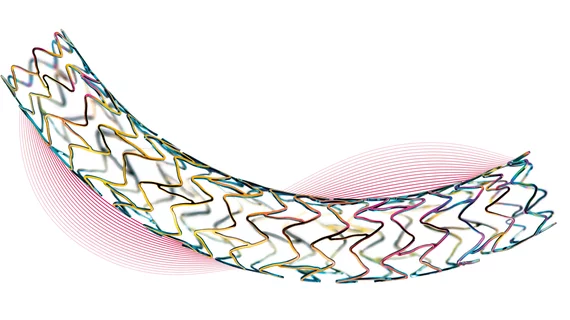Orsiro achieves lower target lesion failure, revascularization than thicker stents
Three-year results of the BIO-RESORT study, presented at EuroPCR this week in Paris, put Biotronik’s ultrathin Orsiro stent ahead of two other competitors in terms of target lesion failure and revascularization.
The all-comers trial enrolled 1,506 patients with small coronary vessels who were treated with either the Orsiro, Resolute Integrity or Synergy drug-eluting stents. Principal investigator Clemens von Birgelen, Thoraxcentrum Twente, MST, Enschede, the Netherlands, and his colleagues tracked patients’ rates of cardiac death, MI, target lesion failure (TLF) and target lesion revascularization (TLR).
According to a release, all three stents showed similar results for cardiac death and myocardial infarction. When it came to target lesion failure, however, the Orsiro’s average rate was 7%, compared to the Synergy’s 9.5% and the Resolute Integrity’s 10%. The thin-strut Orsiro also demonstrated a repeat TLR rate of 2.1%—significantly lower than 4% and 5.3% with the Synergy and Resolute Integrity stents, respectively.
“The BIO-RESORT outcomes add to the growing body of evidence that demonstrate ultrathin strut Orsiro provides real clinical advantages over second-generation, thicker-strut drug-eluting stents,” Alexander Uhl, senior VP of corporate marketing at Biotronik, said in the release. “These favorable results, together with the significant differences in efficacy shown in the SCAAR data at this EuroPCR and BIOFLOW-V, underscore that Orsiro is a tool every interventionalist should have access to.”
A landmark analysis of the stents between one and three years showed divergence was more pronounced after the first year post-procedure, after patients stopped dual antiplatelet therapy. In that period, the TLR rate with Orsiro was 1%, with Synergy 2.7% and with Resolute Integrity 3.7%. Orsiro also showed a trend toward a lower rate of definite or probable stent thrombosis.
“The results may be clinically relevant, as they suggest a relation between the use of ultrathin strut sirolimus-eluting stents and a lower repeat revascularization risk in all-comers patients with small target vessels,” von Birgelen said. “Due to a greater relative impact of stent strut size on lumen obstruction, the substantially thinner struts of these new-generation drug-eluting stents may be particularly advantageous in small vessels.”

